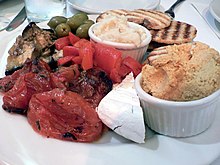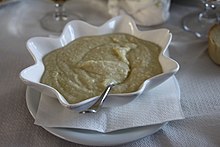 | |
| Type | Puree |
|---|---|
| Region or state | Greece |
| Main ingredients | Garlic |
| Ingredients generally used | Potatoes, walnuts, almonds, bread, olive oil |
Skordalia or skordhalia or skorthalia (Greek: σκορδαλιά [skorðaˈʎa], also called αλιάδα, aliada/aliatha) is a thick purée in Greek cuisine, made of garlic in a base of potatoes, walnuts, almonds or liquid-soaked stale bread mixed with olive oil in to make a smooth emulsion, to which some vinegar is added.[1][2] It is usually made in a mortar and pestle. Skordalia is served as a sauce, side dish, or dip.
Overview
[edit]

Skordalia is the modern equivalent of ancient skorothalmi.[1] The name, on the other hand, may be a pleonastic compound of Greek σκόρδο [ˈskorðo] 'garlic' and Italian agliata [aʎˈʎaːta] 'garlicky'.[3]
Skordalia is usually served with batter-fried fish (notably salt cod, μπακαλιάρος), fried vegetables (notably eggplant and zucchini), poached fish, or boiled vegetables (notably beets). It is sometimes used as a dip.[citation needed]
Variants of skordalia may include eggs as the emulsifier, omitting or reducing the bulk ingredient, which makes for a result similar to the Provençal aïoli and Catalan allioli. In the Ionian Islands, cod stock and lemon are usually added instead of vinegar, and then skordalia is eaten as a main dish.[citation needed]
See also
[edit]- Agliata – an Italian garlic sauce
- Aioli – a Provençal and Catalan garlic sauce
- Garlic sauce
- Tzatziki – a sauce of cucumber, garlic, and yoghurt
- List of bread dishes
- List of dips
- List of garlic dishes
- List of sauces
References
[edit]- ^ a b Davidson, Alan (21 September 2006). The Oxford Companion to Food. OUP Oxford. ISBN 9780191018251 – via Google Books.
- ^ Guardian newspaper: skordalia recipe with potato for body and lemon for sharpness
- ^ Babiniotis, Λεξικό της Νέας Ελληνικής Γλώσσας
Well, that’s interesting to know that Psilotum nudum are known as whisk ferns. Psilotum nudum is the commoner species of the two. While the P. flaccidum is a rare species and is found in the tropical islands. Both the species are usually epiphytic in habit and grow upon tree ferns. These species may also be terrestrial and grow in humus or in the crevices of the rocks.
View the detailed Guide of Psilotum nudum: Detailed Study Of Psilotum Nudum (Whisk Fern), Classification, Anatomy, Reproduction